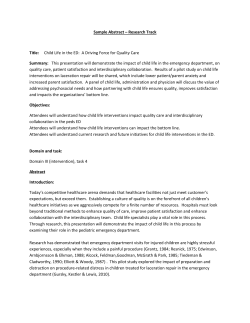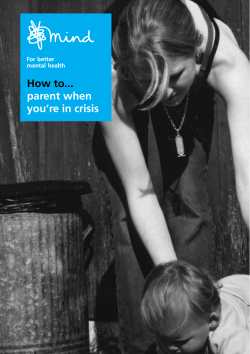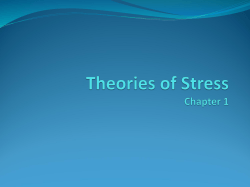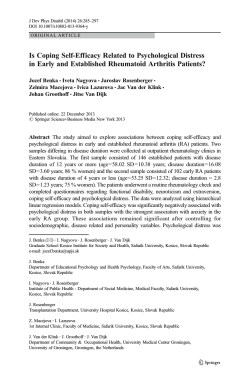
Presentation
Critical Incident Stress Management Overview Chaplain Brian Hamlin Keller & Haltom City Police Departments bhamlin@kellerpd.com Please Answer The Following: Name: Agency: Home: Why Are You Here: What Is Your Off Duty Passion? You Are A Composite Of Your Own Life Experiences CRITICAL INCIDENTS are unusually challenging events that have the potential to create significant human DISTRESS and can overwhelm one’s usual coping mechanisms. The psychological DISTRESS in response to critical incidents such as emergencies, disasters, traumatic events, terrorism, or catastrophes is called a PSYCHOLOGICAL CRISIS (Everly & Mitchell, 1999) PSYCHOLOGICAL CRISIS An acute RESPONSE to a trauma, disaster, or other critical incident wherein: 1. Psychological homeostasis (balance) is disrupted (increased stress) 2. One’s usual coping mechanisms have failed 3. There is evidence of significant distress, impairment, dysfunction (adapted from Caplan, 1964, Preventive Psychiatry) At Any Given Time CRISIS INTERVENTION Goals: To foster natural resiliency through… 1. Stabilization 2. Symptom reduction 3. Return to adaptive functioning, or 4. Facilitation of access to continued care (adapted from Caplan, 1964, Preventive Psychiatry) IMPORTANT! Crisis intervention targets the RESPONSE, not the EVENT, per se. Thus, crisis intervention and disaster mental health interventions must be predicated upon assessment of need. CRISIS INTERVENTION (CI): KEY POINTS Crisis intervention (CI) has a rich history having been developed along two evolutionary pathways: 1) community mental health and suicide intervention, and 2) military psychiatry. Crisis intervention is not a form of psychotherapy, nor a substitute for psychotherapy. As physical first aid is to surgery, crisis intervention is to psychotherapy. As described herein, crisis intervention is not intended to be the practice of psychiatry, psychology, social work, nor counseling, per se, it is simply psychological/emotional first aid As described herein, consistent with NIMH guidelines and Federal “crisis counseling” models, crisis intervention may be practiced by mental health clinicians, as well as, medical personnel, clergy, & community volunteers (although we believe mental health guidance, supervision, or oversight is essential) One approach, that has been frequently used, to integrate such an array of crisis / disaster mental health interventions across a continuum of need is Critical Incident Stress Management (CISM; Everly & Mitchell, 1999). CRITICAL INCIDENT STRESS MANAGEMENT (CISM) (Everly & Mitchell, 1997, 1999; Everly & Langlieb, 2003) A comprehensive, phase sensitive, and integrated, multi-component approach to crisis/disaster intervention. EUSTRESS vs. DISTRESS vs. DYSFUNCTION Three intensity levels of stress: Eustress = Positive, motivating stress Distress = Excessive stress Dysfunction = Impairment DISTRESS (excessive stress). Rx…Identify, Assess, & Monitor vs. DYSFUNCTION (impairment) Rx…Identify, Assess, & Take action SIGNS AND SYMPTOMS OF DISTRESS I. COGNITIVE (Thinking) II. EMOTIONAL III. BEHAVIORAL IV. PHYSICAL V. SPIRITUAL I. COGNITIVE (Thinking) DISTRESS Sensory Distortion Inability to Concentrate Difficulty in Decision Making Guilt Preoccupation (obsessions) with Event Confusion (“dumbing down”) Inability to Understand Consequences of Behavior I. SEVERE COGNITIVE DYSFUNCTION Suicidal/ Homicidal Ideation Paranoid Ideation Persistent Diminished Problem-solving Dissociation Disabling Guilt Hallucinations Delusions Persistent Hopelessness/ Helplessness II. EMOTIONAL DISTRESS Anxiety Irritability Anger Mood Swings Depression Fear, Phobia, Phobic Avoidance Posttraumatic Stress (PTS) Grief II. SEVERE EMOTIONAL DYSFUNCTION Panic Attacks Infantile Emotions in Adults Immobilizing Depression Posttraumatic Stress Disorder (PTSD) Posttraumatic stress (PTS) is a normal survival response; Posttraumatic Stress Disorder (PTSD) is a pathologic variant of that normal survival reaction. PTSD A. Traumatic event B. Intrusive memories C. Avoidance, numbing, depression D. Stress arousal E. Symptoms last > 30 days F. Impaired functioning Predicting PTSD 1. Dose - response relationship with exposure 2. Personal identification with event 3. Very important beliefs violated PTSD results from violation of: 1. EXPECTATIONS 2. DEEPLY HELD BELIEFS (Worldviews) CORE BELIEFS (Worldviews) Belief in a just and fair world Need to trust others Self-esteem, Self-efficacy Need for a predictable and SAFE world Spirituality, belief in an order and congruence in life and the universe Severity of PTSD Dissociation Psychogenic amnesia Persistent sleep disturbance Panic Severe exaggerated startle response Evidence of seizures III. BEHAVIORAL DISTRESS Impulsiveness Risk-taking Excessive Eating Alcohol/ Drug Use Hyperstartle Compensatory Sexuality Sleep Disturbance Withdrawal Family Discord Crying Spells Hypervigilance 1000-yard Stare III. SEVERE BEHAVIORAL DYSFUNCTION Violence Antisocial Acts Abuse of Others Diminished Personal Hygiene Immobility Self-medication IV. PHYSICAL DISTRESS Tachycardia or Bradycardia Headaches Hyperventilation Muscle Spasms Psychogenic Sweating Fatigue / Exhaustion Indigestion, Nausea, Vomiting IV. SEVERE PHYSICAL DYSFUNCTION Chest Pain Persistent Irregular Heartbeats Recurrent Dizziness Seizure Recurrent Headaches It is imperative that all evidence of physical dysfunction be taken seriously and referred to a physician. The same is true when dealing with any physical distress that does not remit, may be suggestive of a medical disorder, or seems ambiguous. V. SPIRITUAL DISTRESS Anger at God Withdrawal from Faith-based Community Crisis of Faith V. SEVERE SPIRITUAL DYSFUNCTION Cessation from Practice of Faith Religious Hallucinations or Delusions VI. Relational Withdrawal from family, coworkers, colleagues Withdrawal from organizations or other affiliations Isolation Stigma, racism, sexism, media response VI. Relational Discontinued educational pursuits Lack of community or political involvement Secondary injuries from friends, family, social & professional affiliations contribute to additional stress NOTE! ALL OF THE SIGNS AND SYMPTOMS OF SEVERE DYSFUNCTION WARRANT REFERRAL TO THE NEXT LEVEL OF CARE! Also refer whenever in doubt. A Comprehensive, Integrated Multi-Component Crisis Intervention System (adapted from: Martha Starr) Each “leaf” represents a specific tactical intervention. ELEMENTS OF CISM Pre-incident education, preparation Assessment Strategic Planning Large Group Crisis Intervention: Demobilizations (large groups of rescue / recovery) Respite / Rehab Sectors Crisis Management Briefings (CMB) ELEMENTS OF CISM Small Group Crisis Intervention: Defusings (small groups) Small group CMB “Debriefing” Models: Critical Incident Stress Debriefing (CISD); HERD; NOVA; Multi-stressor debriefing model; CED ELEMENTS OF CISM One-on-one crisis intervention, including individual PFA Family CISM Organizational / Community intervention, consultation Pastoral crisis intervention Follow-up and referral for continued care The challenge in crisis intervention is not only developing TACTICAL skills in the “core intervention competencies,” but is in knowing WHEN to best STRATEGICALLY employ the most appropriate intervention for the situation. STRATEGIC PLANNING FORMULA 1. THREAT 2. TARGET (Who should receive services? ID target groups.) 3. TYPE (What interventions should be used?) 4. TIMING (When should the interventions be implemented, with what target groups?) STRATEGIC PLANNING FORMULA 5. RESOURCES (What intervention resources are available to be mobilized for what target groups, when? Consider internal and external resources.) [Note: THEMES which may modify impact and response should be considered (children, chem-bio hazards, etc?)] Remember Maslow’s (1943) Need Hierarchy Self – actualization Self – esteem Affiliation Safety Basic physical needs (START HERE) CRISIS COMMUNICATION TECHNIQUES Paracommunications: Silence and Nonverbal Behavior “Mirror” Techniques Questions Action Directives BEWARE! Excessive use of silence in crisis situations can communicate lack of interest, thus causing an escalation. Nonverbal behavior sends a powerful message. Often, the first impression you make is based upon how you look. The challenge is how to make that impression useful in the service of crisis intervention. “MIRROR TECHNIQUES” Restatement Paraphrase (Summary & Extrapolation) Reflection of Emotion (Commonly Used By Hostage Negotiators) “MIRROR” TECHNIQUES Are effective when placed at a natural pause in the conversation Or, may be used to redirect the flow of a tangential conversation Or, can be used break an escalating emotional spiral RESTATEMENT Takes the other person’s words and restates only the term or phrase about which you wish to inquire or emphasize Do not overdo this technique Demonstrates concern, listening SUMMARY PARAPHRASE Simply summarizes in your words, the main points made by the person in crisis Usually inserted when the person pauses Stems might include: “So, in other words…” or “Sounds like…” or “What I’m hearing you say is…” EXTRAPOLATION PARAPHRASE People in crisis seldom understand the consequences of their actions Extrapolation = summary + consequences May be a behavior change tool REFLECTING EMOTION Based upon verbal or nonverbal cues Attempts to accurately label the experienced emotion of the other person (“you seem really angry…”) Builds empathy, rapport Encourages ventilation Helps defuse anger QUESTIONS CLOSED-END (“do you…?” “Is this…?” “Did you…?”) Multiple choice Open-end (“How?” “What”) Remember, paraphrases and reflections are closedend questions A simple structure for asking questions is called the “diamond” structure. “DIAMOND” STRUCTURE Begin asking closed-ended questions in order to establish basic facts Move to open-ended questions in order to probe and obtain more information Use paraphrase and reflection of emotion to summarize key points and acknowledge emotions CLOSED END QUESTION (“YES-NO”) TO ESTABLISH FACTS OPEN QUESTIONS TO PROBE/ EXPAND PARAPHRASE (closed question) TO SUMMARIZE ACTION DIRECTIVES Providing direction on what to do If someone asks a direct question, it is usually best to provide a direct answer, unless the answer will cause an escalation of the crisis PSYCHOLOGICAL ALIGNMENT Don’t argue Don’t minimize problem Find something to agree upon Establish Report AVOID! “I know how you feel.” “It’s not so bad.” “This was God’s will.” “God won’t give you more than you can handle.” “Others have it much worse.” AVOID! “You need to forget about it.” “You did the best you could.” (Unless person has told you that.) “You really need to experience this pain.” Psychotherapeutic interpretation! Confrontation Paradoxical intention. CRISIS = RESPONSE The failure to understand that the event is NOT the crisis, can easily lead to over intervention, and the potential to interfere with natural recovery mechanisms! CAN CRISIS INTERVENTION BE HARMFUL ? Theoretical Mechanisms/ Issues (see Dyregrov, IJEMH, 1999; Watson, et al., in Ursano & Norwood, 2003) Excessive catharsis, disclosure, rumination Pathologizing otherwise “normal” reactions Vicarious traumatization in groups Coercive peer pressure in groups Scapegoating in groups CAN CRISIS INTERVENTION BE HARMFUL ? Theoretical Mechanisms/ Issues (see Dyregrov, IJEMH, 1999; Watson, et al., in Ursano & Norwood, 2003) Triggering of previous traumatic memories Intervention may be premature (inappropriate timing) May be inappropriate with highly aroused persons May interfere with natural coping mechanisms May not be accompanied by adequate assessment or follow-up CAUTION! It is important for the interventionist to keep in mind the following points: 1. 2. 3. The majority of individuals exposed to a traumatic event will not need formal psychological intervention, beyond being provided relevant information. The focus should be upon the individual more so than the event; assessment is essential. Assessment is an ongoing dynamic process, rather than a discrete, static stage. Normalization of the crisis response is to be encouraged, but should never lead one to dismiss serious crisis reactions. CAUTION! It is important for the interventionist to keep in mind the following points: 4. 5. 6. 7. 8. Unless the magnitude of impairment is such that the individual represents a threat to self or others, crisis intervention should be voluntary. The interventionist must be careful not to interfere with natural recovery or adaptive compensatory mechanisms. The potential for vicarious traumatization must be reduced. Individuals should not be encouraged to talk about or relive the event, unless they are comfortable doing so. When in doubt, seek assistance, supervision. The risk of adverse outcome is associated with all human intervention and helping practices including medicine, surgery and counseling. Improper, inadequate training would appear the greatest risk factor associated with crisis intervention, as well as those practices just mentioned. Thus, training and supervision may be the best way to reduce the risk of adverse outcome, rather than simply calling for an end to such helping practices SUICIDE: A SPECIAL CASE Helplessness Hopelessness Extreme guilt Previous attempts Severe illness, disability Psychosis SUICIDE: C-C-D-R Intervention CLARIFY CONTRADICT DELAY REFER for continued to care SUICIDE INTERVENTION CLARIFY: “Do you really want to die, or do you simply want to change the way you live your life? CONTRADICT via: Desired outcome will not be achieved Suicide will create more problems than it solves Suicide creates an adverse and undesired “ripple effect” affecting others SUICIDE INTERVENTION DELAY ALWAYS ASSIST IN ACCESSING HIGHER LEVEL OF CARE The Johns Hopkins’ RESISTANCE, RESILIENCE, RECOVERY An outcome-driven continuum of care Create Resistance Assessment Intervention Evaluation Enhance Resiliency Assessment Intervention Evaluation Speed Recovery Assessment Intervention Evaluation [Kaminsky, et al, (2005) RESISTANCE, RESILIENCE, RECOVERY. In Everly & Parker, Mental Health Aspects of Disaster: Public Health Preparedness and Response. Balto: Johns Hopkins Center for Public Health Preparedness. Crisis Intervention applications can be made easier by the utilization of simple models. The SAFER-R model is nothing more than a step-by-step model for working with individuals in crisis The SAFER-Revised Stabilize (introduction; meet basic needs; mitigate acute stressors) Acknowledge the crisis (event, reactions) Facilitate understanding (normalization) Encourage effective coping (mechanisms of action) Recovery or Referral (facilitate access to continued care) SAFER-R Model of Crisis Intervention with Individuals (Everly, 2001) Stabilization (plus Introduction ) [1] Acknowledgement [1] A. Event B. Reactions Facilitation of Understanding: Normalization [1] Encourage Effective Coping (Mechanisms of Action) [1,2,3] Referral? [1, 2, 3] [1= Assessment, 2= Generate intervention options, 3= Implement interventions] SAFER-R Model of Crisis Intervention with Individuals (Everly, 2001) Stabilization (plus Introduction ) [1] Acknowledgement [1] A. Event B. Reactions Facilitation of Understanding: Normalization [1] Encourage Effective Coping (Mechanisms of Action) [1,2,3] MEETING BASIC NEEDS LIAISON/ ADVOCACY CATHARTIC VENTILATION SOCIAL SUPPORT INFORMATION STRESS MANAGEMENT PROBLEM-SOLVING CONFLICT RESOLUTION COGNITIVE REFRAMING SPIRITUAL Referral? [1, 2, 3] [1= Assessment, 2= Generate intervention options, 3= Implement interventions] AN EXAMPLE Introduce yourself Meet basic needs, stabilize, liaison Listen to the “story” (events, reactions) Reflect emotion Paraphrase content AN EXAMPLE Normalize Attribute reactions to situation, not personal weakness Identify personal stress management tools to empower Identify external support / coping resources Use problem-solving or cognitive reframing, if applicable Assess person’s ability to safely function SAFER-R Model of Crisis Intervention with Individuals (Everly, 2001) Stabilization (plus Introduction ) [1] Acknowledgement [1] A. Event B. Reactions Facilitation of Understanding: Normalization [1] Encourage Effective Coping (Mechanisms of Action) [1,2,3] MEETING BASIC NEEDS LIAISON/ ADVOCACY CATHARTIC VENTILATION SOCIAL SUPPORT INFORMATION STRESS MANAGEMENT PROBLEM-SOLVING CONFLICT RESOLUTION COGNITIVE REFRAMING SPIRITUAL Referral? [1, 2, 3] [1= Assessment, 2= Generate intervention options, 3= Implement interventions] The risk of adverse outcome is associated with all human intervention and helping practices including medicine, surgery and counseling. Improper, inadequate training would appear the greatest risk factor associated with crisis intervention, as well as those practices just mentioned. Thus, training and supervision may be the best way to reduce the risk of adverse outcome, rather than simply calling for an end to such helping practices Care Without Carrying What Is NOT Covered!! Individual Crisis Intervention/Peer Support Establish the Need Terrorism: A Special Case Foundations of Military Research Findings Reasonable Evidence Based Conclusions “John Hopkins” Perspectives Categories of Disaster Mental Health Interventions Elements of CISM Core Competencies of Comprehensive Crisis Intervention Pre-Incident Preparation Assessment Strategic Planning Formula Peer Support: Credibility, When, Cautions Communication Exercises The SEA-3 Mental Status Exam Crisis Intervention Mechanisms Exercise Role of Psychological Therapy The Non-Communicative Person The Dazed or Non-Responsive Person The Emotional Tirade The Verbally Abusive Person Establishing Credibility Personal/Professionally Knowing Own Limits Assessing: Problem-Crisis-Emergency Referrals Forgotten Factors in Communications Peer Concerns Family Pressures Personal Habits Risk Level Work Environment Feelings Attitudes and Values Decision Making Identify Additional Info Alternatives + Influencing Factors Choice Action Plan/Steps ACTS Discovery Psychological First Aid Pre-Incident Education Courses To Take!! Individual Crisis Intervention and Peer Support Group Crisis Intervention Suicide Prevention, Intervention and Postvention Life Is About Relationships You Are A Composite Of Your Own Life Experiences!!
© Copyright 2025














